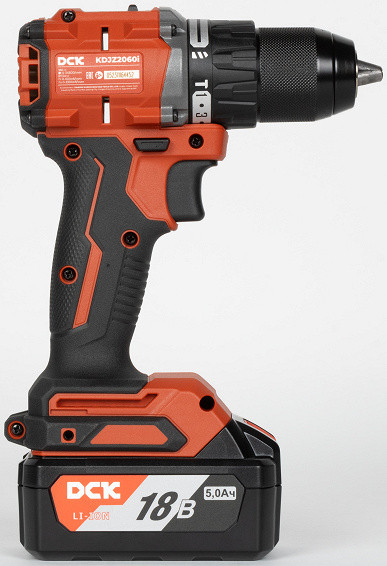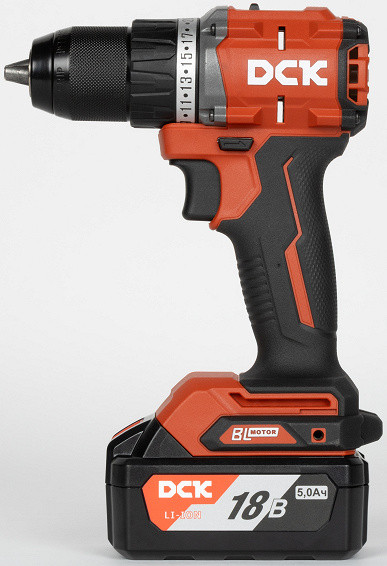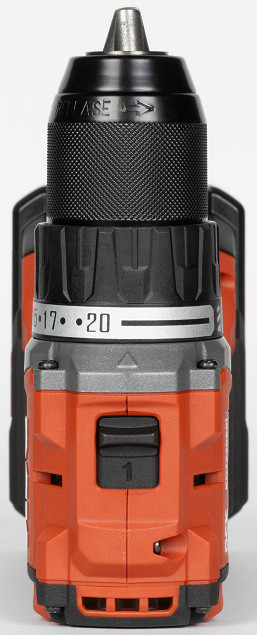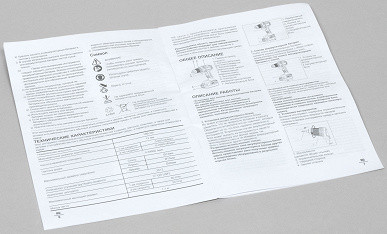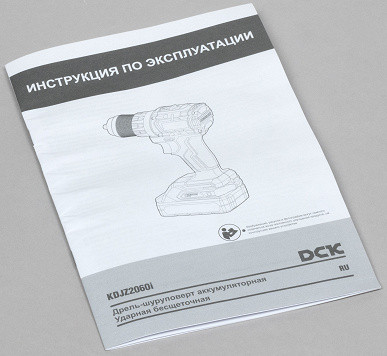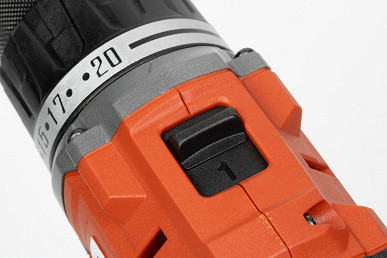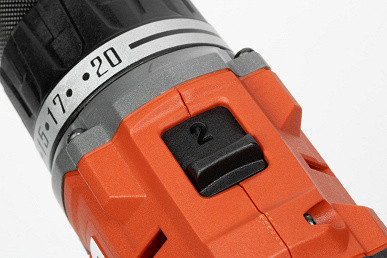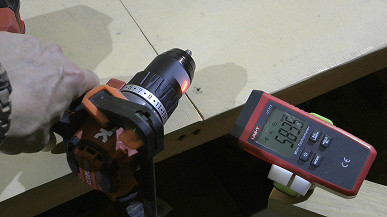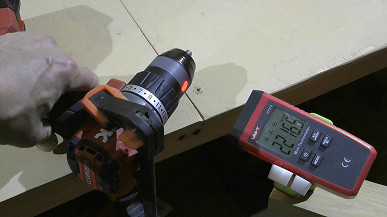Today we will consider another model of a screwdriver from the DCK brand. Let us note right away that this is a standard screwdriver, but with an impact drilling function. Of course, it has its pros and cons, like any tool.
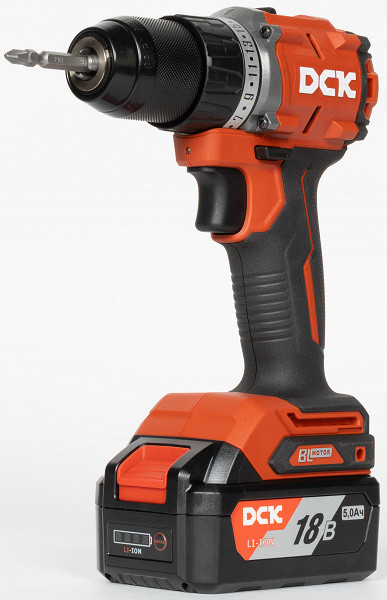
Characteristics
The main characteristics of the tool are presented in the table. This and other information can be found on the model page .
| Manufacturer | DCK |
|---|---|
| Model (article) | KDJZ2060i |
| Device type | Hand-held cordless impact drill-driver with removable battery |
| Engine type | brushless |
| Chuck type, diameter | quick-release with lock, up to 13 mm |
| Reverse mechanism | There is |
| Impact function | yes, 34,500 bpm |
| Speed | 2 ranges, max speed:
|
| Torque |
|
| Built-in backlight | yes, top type |
| Dimensions W×H×D, weight | 160×200×55 mm, 1.1 kg without battery |
| Price at the time of review preparation | $77 |
| Battery | |
| Type | Removable lithium-ion |
| Voltage | 18 V |
| Capacity | 5000 mAh (90 Wh) |
| Charging time | 90 minutes |
| Efficiency, operating time (measured) |
|
Equipment
The screwdriver is supplied in an irregularly shaped cardboard box with a branded color scheme.
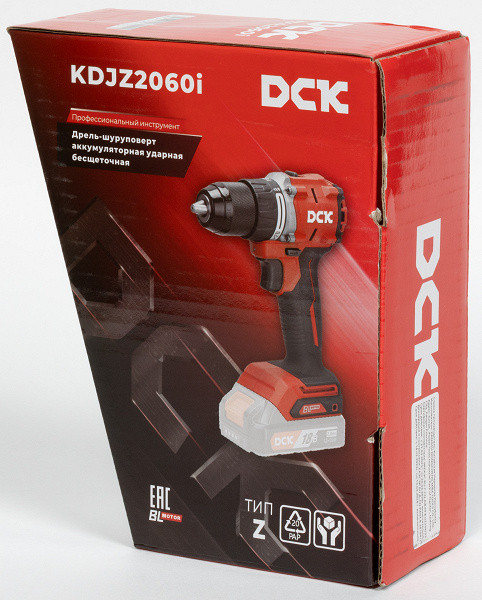
The screwdriver comes with a removable clip, a double-ended Phillips bit and documentation. The battery is not included, so we used the one we had, although it turned out to be too large, but this is not critical.
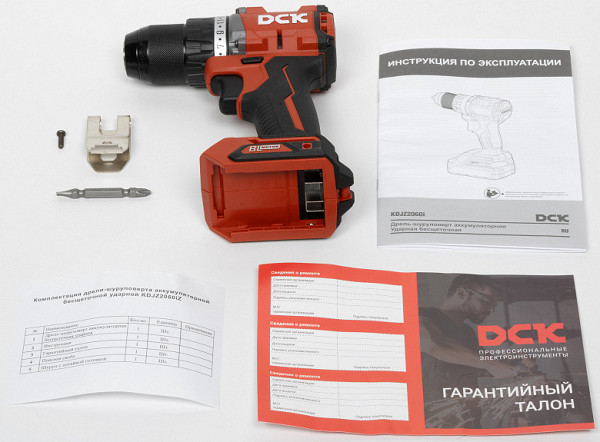
The absence of a battery in the kit is quite expected for manufacturers who have created a whole line of tools that operate on one battery. Such a system of interchangeability is called an ecosystem. It is assumed that the buyer of this screwdriver already owns DCK equipment and has at least one 18-volt battery. It does not matter what tool it is intended for, even if this is the only battery, it will fit all devices in this line.
At first glance
One of the key parameters of a screwdriver is its dimensions, especially the length of the working part. The shorter it is, the more convenient it is to work in a limited space. This screwdriver has a working part length of about 160 mm from the rear of the engine to the end of the clutch, which can be called compact, although this is not a record figure.
Otherwise, the design and construction are no different from standard conventional screwdrivers.
The screwdriver handle has numerous rubber inserts, thanks to which the tool is securely held in the hand.
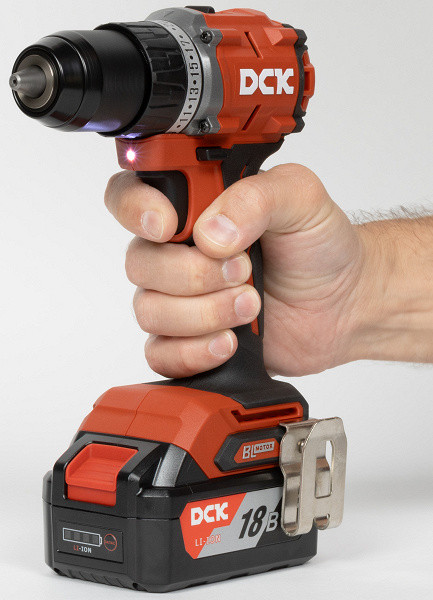
The front part of the tool, the gearbox, is made of a metal alloy. The chuck shell is also metal. The chuck is quick-clamping, with a spindle lock, which allows you to change the tool with one hand. In serious models of screwdrivers, such chucks have long been standard.
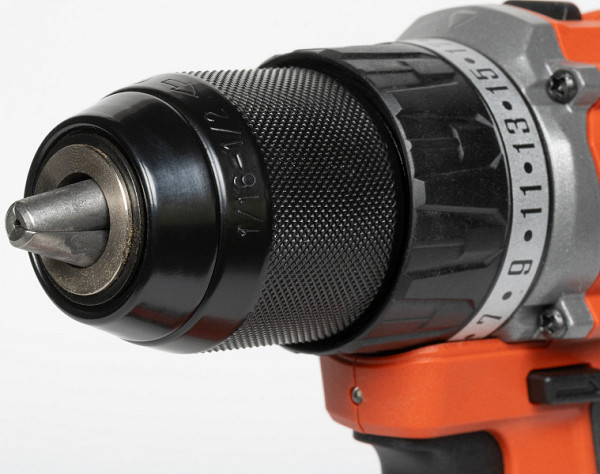
The chuck is attached to the spindle with a cross-head screw with reverse thread. To change the chuck or perform its maintenance, you will need a short cross-head screwdriver.
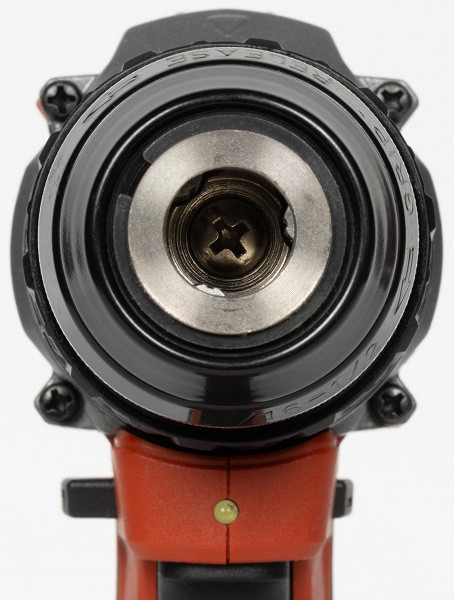
The built-in lighting is located at the top and is used in most screwdrivers.
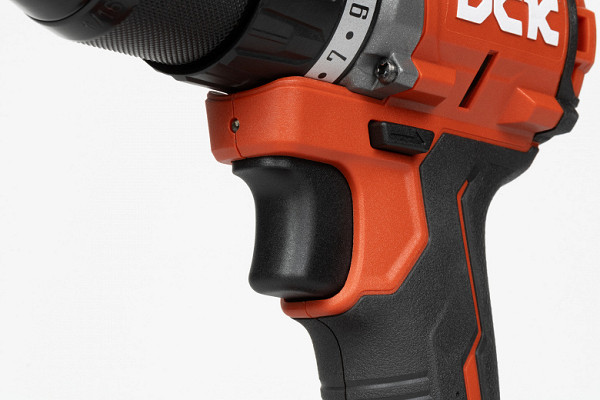
It is worth noting a convenient detail — the presence of a mounting bracket. It can be reinstalled on either side of the body, which makes the tool convenient for both right-handed and left-handed people. The bracket is especially useful when working at height or in difficult conditions when both hands are busy. You can’t put a screwdriver in your pocket, but it is easy to hook it onto the bracket.
Instructions
The instructions included with the charger and impact wrench clearly explain not only the safety precautions, but also the tool's structure and how to work with it. The only downside is that the illustrations are too small, but this has long become commonplace.
Control
The full stroke of the tool's trigger lever is 8.5 mm, with the first 3 mm being idle. After pressing the lever more than 3 mm, the backlight turns on and the engine starts at low speed. When pressing further, the spindle speed gradually increases to the maximum. Thus, 5.5 mm remains for adjusting the rotation speed.
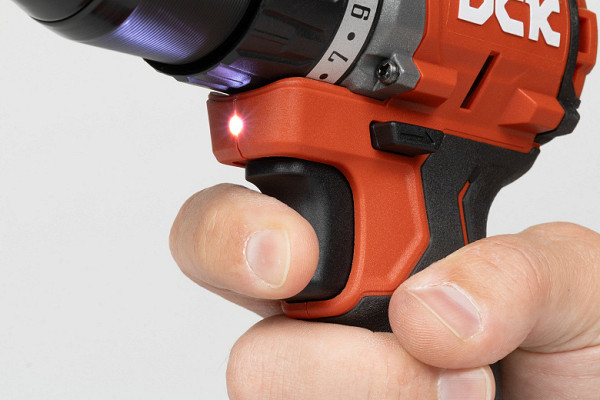
When you release the lever, the backlight immediately turns off, which is a drawback. It would be more convenient if the LED remained on for a while, allowing you to use the tool as a flashlight.
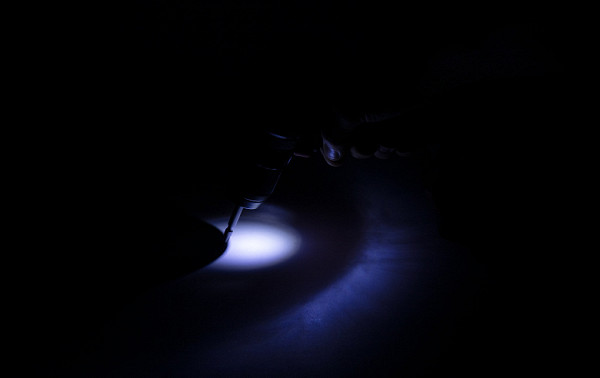
The direction of spindle rotation is controlled by a standard electronic switch that changes the polarity of the motor power supply. In the middle position, the switch locks the trigger, which is convenient for storing and transporting the tool.
The ring with numbers regulates the torque, and each position is fixed with a clear, audible click. By turning the ring further, the tool switches to the drilling mode, in which the «ratchet» is turned off. The last position of the ring turns on the drilling mode with impact.
Having measured the rotation speed of the chuck, we found almost complete agreement with the passport values: 600 revolutions per minute according to the specification and 580 according to measurements. In the second speed range, the results are also close: 2300 revolutions according to the passport and 2216 according to measurements. The difference is insignificant.
The battery is inserted into the “rails” of the lower platform and is firmly fixed with side latches.
Operation
The screwdriver in question, like its modern counterparts, is equipped with a protection system. The tool automatically stops in the following cases:
- Overload: if it consumes abnormally high current.
- Overheating: the tool and battery need time to cool down before restarting.
Other operating rules are standard for all screwdrivers:
- The operating mode must match the task. For drilling, you need to switch to the 2nd speed and set the ratchet ring to the drill mode to avoid critical overheating of the motor.
- When working with screws, bolts and nuts, it is better to use the 1st speed. In order not to damage the fastener heads, you should set the torque to a position corresponding to the length, thickness and density of the material (selected experimentally). However, working at the first speed may seem very slow.
- Long-term use of low speed is not recommended, as this increases the risk of motor overheating.
Care
The chuck, motor and battery are three key components that require attention and care. The chuck should be cleaned regularly from dirt. It is not recommended to store the screwdriver in damp or unheated rooms. During storage, it is advisable to move the reverse switch to the middle position. It is also useful to regularly recharge the battery.
Our measurements
Torque. Test that is not available
Torque is the force with which the spindle rotates, and therefore the inserted tooling. We measure torque on a simple stand
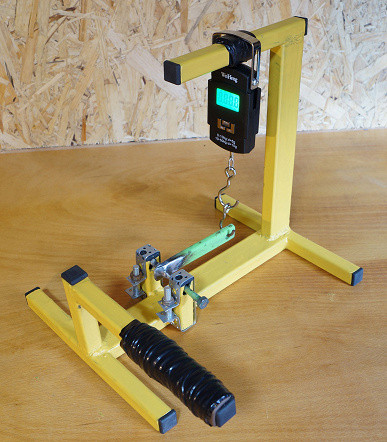
The peculiarity of the measurements is that the screwdriver must operate in drilling mode, i.e. with the ratchet turned off. This is safe, since the built-in protection prevents the motor from overheating, but even one or two seconds of operation under load allow you to measure the torque.
However, in this case, the screwdriver protection is triggered instantly, which makes the test impossible. This feature leads to unpleasant consequences during real work: the tool does not try to complete the task, but immediately refuses to work, having estimated the upcoming force.
The following table shows the torques of various screwdrivers that passed our stand. They are sorted by the dates of publication of reviews (above — earlier, below — later), and the model name is a link to the corresponding review.
| Model | Battery voltage, V | Cr. moment passport, N m | Measured torque, Nm | Discrepancy, times |
|---|---|---|---|---|
| Deko GCD12DU3 | 12 | 32 | 7 | 4.6 |
| Kolner KCD 12M | 12 | 14 | 7 | 2.0 |
| Zitrek Green 12 | 12 | 32 | 4 | 8.0 |
| Bosch Ixo | 3.6 | 4.5 | 3.5 | 1.3 |
| Stanley SBD201M2K | 18 | 55 | 55 | 1.0 |
| Tonfon 12V | 12 | 25 | 12.5 | 2.0 |
| Worx AiDrill WX178 | 20 | 20 | 8.3 | 2.4 |
| Black+Decker BL186K1B2 | 18 | 52 | — | — |
| Metabo PowerMaxx BS Basic | 12 | 34 | 19.5 | 1.7 |
| Metabo PowerMaxx BS BL | 12 | 38 | — | — |
| Deko DKCD20FU-Li | 20 | 42 | 5.3 | 7.9 |
| Interskol DA-10/12V | 12 | 36 | 11.5 | 3.1 |
| Bort BAB-12x2Li-FD | 12 | 36 | 6.2 | 5.8 |
| Nocord NCD-12.1.15.B | 12 | 25 | 12 | 2.1 |
| Worx WX354 | 20 | 60 | — | — |
| Toua DBLD120 | 12 | 40 | 4.7 | 8.5 |
| Zubr DSL-125-22 | 12 | 15 | 10 | 1.5 |
| DCK KDPL04-8 Impact | 10.8 | 140 | — | — |
| DCK KDJZ2060i | 18 | 60 | — | — |
So, the test failed before it even started. But we can still evaluate the potential of the screwdriver (though not in Newton meters), for this we will try to screw different types of screws into wood.
As you can see, the long thin screw was only able to be screwed into the wood after switching the tool to drilling mode. The overly sensitive «ratchet» does not allow using the full potential of the engine even at maximum force. The thick screw with a large hex head was driven into the wood only two-thirds, even in drilling mode. This is worth considering: before screwing in long and/or thick screws, you must first drill a hole.
To be fair, it should be noted that only a few screwdrivers are capable of screwing in a screw with a diameter of 8 mm without pre-drilling. In such cases, either an impact mechanism is required (which already makes the tool an impact wrench), or a very powerful and heavy engine.
By the way, about drilling. In order not to overload the article with a lot of videos, the drilling process was demonstrated in the same video. It is important to note the impact mode: it is obvious that in this mode the drill penetrates the material much faster. A screwdriver, of course, is not a hammer drill, but it can handle a brick. As for reinforced concrete, doubts already arise.
Autonomy: An unscientific test with an unusually high result
In this practical test, we will screw 50 mm long and 3.5 mm diameter screws into dry wood (pine). The purpose of the test is to determine the number of screws the screwdriver can screw in on one charge of the included battery. The battery is fully charged before starting work.
The screwdriver in question worked for 4 hours and 16 minutes from a fully charged battery, during which time it screwed in 1005 screws. The author asks that you no longer send screwdrivers with SUCH batteries for testing.
The following table shows the battery capacities of the screwdrivers tested in watt-hours and the number of screws screwed in. Based on this data, the amount of energy expended by the screwdriver to screw in one screw is calculated. Thus, we obtain the efficiency: the higher its value, the more efficiently the screwdriver works.
| Model | Battery voltage, V | Battery capacity, Wh (V Ah) | Self-tapping screws screwed in, pcs. | Efficiency (higher = better) |
|---|---|---|---|---|
| Deko GCD12DU3 | 12 | 18 | 210 | 11.7 |
| Kolner KCD 12M | 12 | 12 | 28 | 2,3 |
| Zitrek Green 12 | 12 | 18 | 222 | 12.3 |
| Bosch Ixo | 3.6 | 5.4 | 0 | 0,0 |
| Stanley SBD201M2K | 18 | 72 | 1293 | 18.0 |
| Tonfon 12V | 12 | 24 | 376 | 15.7 |
| Worx AiDrill WX178 | 20 | 40 | 750 | 18.8 |
| Black+Decker BL186K1B2 | 18 | 36 | 717 | 19.9 |
| Metabo PowerMaxx BS Basic | 12 | 24 | 413 | 17.2 |
| Metabo PowerMaxx BS BL | 12 | 24 | 387 | 16.1 |
| Deko DKCD20FU-Li | 20 | 40 | 525 | 13.1 |
| Interskol DA-10/12V | 12 | 18 | 286 | 15.8 |
| Bort BAB-12x2Li-FD | 12 | 18 | 176 | 9.7 |
| Nocord NCD-12.1.15.B | 12 | 18 | 266 | 14.7 |
| Worx WX354 | 20 | 40 | 705 | 17.6 |
| Toua DBLD120 | 12 | 24 | 401 | 16.7 |
| Zubr DSL-125-22 | 12 | 24 | 293 | 12.2 |
| DCK KDPL04-8 Impact | 10.8 | 21.6 | 484 | 22.4 |
| DCK KDJZ2060i | 18 | 90 | 1005 | 11.1 |
Despite the huge number of screws that the screwdriver managed to master during testing, the final efficiency was below average — only 11.1. For comparison, Metabo screwdrivers demonstrate an efficiency in the range of 16-17, and the budget Nocord from Yandex — almost 15. Surprisingly, the previously reviewed tool of the same brand DCK showed an impressive coefficient of 22.4, which is twice the result of the hero of this review. However, it is worth noting that this was an impact wrench using a tangential impact, which seems to really double the efficiency. Now about personal impressions of using the tool. During the testing, having screwed in more than a thousand screws and made quite a few holes, I noticed that this tool has two mechanisms that limit the potential power of the engine. The first of them is the «ratchet», which is triggered too early; in my opinion, it should be strengthened by at least a third, if not half. The second mechanism is the motor protection, which instantly switches off the motor when it encounters unexpected high resistance (for example, when it hits a small knot or an uneven edge of the screw thread). Interestingly, these two mechanisms sometimes conflict, as if competing to see who will stop the work faster. It happens that the ratchet does not have time to work, and the motor protection reacts first. However, after switching off, the screwdriver can again successfully screw in the screw, which just seemed insurmountable to it.
The principle of reasonable sufficiency
One of the most interesting tables sums up the question of “is this tool worth the money?” It doesn’t take into account advantages such as multi-row lighting or electronic control, and considers the screwdriver solely as a device for screwing in screws. The formula is simple: the price of the screwdriver is divided by the number of screws it screwed in, resulting in a fair price indicator. The lower the resulting figure, the more profitable it is to own this tool.
However, our case is a little special. The price of the screwdriver indicated in the specifications table is not entirely fair, since the battery is not included. Therefore, we need to add the cost of the battery that was used to achieve an impressive result of 1005 screws. But here is a problem: we did not find batteries with a capacity of 5000 mAh on sale — only 4000 and 6000 mAh are available. In the end, we will take the price of the most capacious battery — $85. Thus, the cost of a cordless screwdriver will be $164, which is a fair compromise.
| Model | Price, RUB | Self-tapping screws screwed in, pcs. | Price/screws (less = better) |
|---|---|---|---|
| Deko GCD12DU3 | 1574 | 210 | 7.5 |
| Kolner KCD 12M | 2500 | 28 | 89.3 |
| Zitrek Green 12 | 1183 | 222 | 5.3 |
| Bosch Ixo | — | — | |
| Stanley SBD201M2K | 23270 | 1293 | 18.0 |
| Tonfon 12V | — | — | |
| Worx AiDrill WX178 | 15292 | 750 | 20.4 |
| Black+Decker BL186K1B2 | 11980 | 717 | 16.7 |
| Metabo PowerMaxx BS Basic | 8399 | 413 | 20.3 |
| Metabo PowerMaxx BS BL | 12990 | 387 | 33.6 |
| Deko DKCD20FU-Li | 4045 | 525 | 7.7 |
| Interskol DA-10/12V | 5218 | 286 | 18.2 |
| Bort BAB-12x2Li-FD | 2990 | 176 | 16.9 |
| Nocord NCD-12.1.15.B | 1499 | 266 | 5.6 |
| Worx WX354 | 24790 | 705 | 35.1 |
| Toua DBLD120 | 6300 | 401 | 15.7 |
| Zubr DSL-125-22 | 6390 | 293 | 21.8 |
| DCK KDPL04-8 Impact | 12590 | 484 | 26.0 |
| DCK KDJZ2060i | 15880 | 1005 | 15.8 |
It turns out that even with such an expensive battery, the benefit of owning a tool is quite justified. The indicator of 15.8 is average «in the shop». The result is not a record, but not an outsider either.
Screwdriver: battery
The screwdriver does not come with a battery, so for testing we used a 5000 mAh battery with a voltage of 18 V (90 Wh). The battery has a built-in charge level indicator.
Conclusions
The DCK KDJZ2060i impact drill/driver is compact in size and has a quick-release chuck with a lock. It has medium power, and its high autonomy is ensured by a capacious battery.
Pros:
- three operating modes, including impact drilling
- quick-release chuck with spindle lock
- a bracket for attaching to clothing
Cons:
- too sensitive engine protection system

